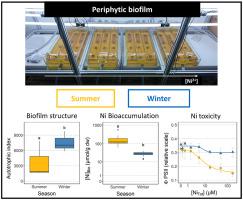Environmental Pollution ( IF 7.6 ) Pub Date : 2022-09-30 , DOI: 10.1016/j.envpol.2022.120223 Vincent Laderriere 1 , Soizic Morin 2 , Mélissa Eon 3 , Claude Fortin 1

|
Metals are naturally present in freshwater ecosystems but anthropogenic activities like mining operations represent a long-standing concern. Metals released into aquatic environments may affect microbial communities such as periphytic biofilm, which plays a key role as a primary producer in stream ecosystems. Using two 28-day microcosm studies involving two different photoperiods (light/dark cycle of 16/8 vs 8/16), the present study assessed the effects of four increasing nickel (Ni) concentrations (0–6 μM) on two natural biofilm communities collected at different seasons (summer and winter). The two communities were characterized by different structural profiles and showed significant differences in Ni accumulated content for each treatment. For instance, the biofilm metal content was four times higher in the case of summer biofilm at the highest Ni treatment and after 28 days of exposure. Biomarkers examined targeted both heterotrophic and autotrophic organisms. For heterotrophs, the β-glucosidase and β-glucosaminidase showed no marked effects of Ni exposure and were globally similar between the two communities suggesting low toxicity. However, the photosynthetic yield confirmed the toxicity of Ni on autotrophs with maximum inhibition of 81 ± 7% and 60 ± 1% respectively for the summer and winter biofilms. Furthermore, biofilms previously exposed to the highest long-term Ni concentration ([Ni2+] = 6 μM) revealed no acute effects in subsequent toxicity based on the PSII yield, suggesting a tolerance acquisition by the phototrophic community. Taken together, the results suggest that the biofilm response to Ni exposure was dependent of the function considered and that descriptors such as biofilm metal content could be seasonally dependent, information of great importance in a context of biomonitoring.
中文翻译:

夏季和冬季收获的附生生物膜对镍的脆弱性和耐受性
金属自然存在于淡水生态系统中,但采矿作业等人为活动是一个长期存在的问题。释放到水生环境中的金属可能会影响微生物群落,例如附生生物膜,它在河流生态系统中作为初级生产者发挥着关键作用。本研究使用涉及两个不同光周期(光/暗周期为 16/8 与 8/16)的两项为期 28 天的微观世界研究,评估了四种增加的镍 (Ni) 浓度 (0–6 μM) 对两种天然生物膜的影响在不同季节(夏季和冬季)收集的社区。这两个群落的特征在于不同的结构剖面,并且在每个处理中显示出显着的镍积累含量差异。例如,在最高 Ni 处理和暴露 28 天后,夏季生物膜的生物膜金属含量高出四倍。检查的生物标志物针对异养和自养生物。对于异养生物,β-葡萄糖苷酶和 β-氨基葡萄糖苷酶没有显示出镍暴露的显着影响,并且两个群落之间的全局相似表明毒性较低。然而,光合产量证实了 Ni 对自养生物的毒性,夏季和冬季生物膜的最大抑制分别为 81 ± 7% 和 60 ± 1%。此外,先前暴露于最高长期 Ni 浓度的生物膜([Ni β-葡萄糖苷酶和 β-氨基葡萄糖苷酶没有显示出暴露于 Ni 的显着影响,并且两个群落之间的总体相似表明毒性较低。然而,光合产量证实了 Ni 对自养生物的毒性,夏季和冬季生物膜的最大抑制分别为 81 ± 7% 和 60 ± 1%。此外,先前暴露于最高长期 Ni 浓度的生物膜([Ni β-葡萄糖苷酶和 β-氨基葡萄糖苷酶没有显示出暴露于 Ni 的显着影响,并且两个群落之间的总体相似表明毒性较低。然而,光合产量证实了 Ni 对自养生物的毒性,夏季和冬季生物膜的最大抑制分别为 81 ± 7% 和 60 ± 1%。此外,先前暴露于最高长期 Ni 浓度的生物膜([Ni2+ ] = 6 μM) 显示基于 PSII 产量的后续毒性没有急性影响,表明光养群落获得了耐受性。总之,结果表明生物膜对 Ni 暴露的反应取决于所考虑的功能,并且生物膜金属含量等描述符可能具有季节性依赖性,这些信息在生物监测的背景下非常重要。











































 京公网安备 11010802027423号
京公网安备 11010802027423号